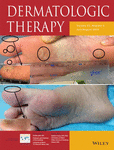CLAPO syndrome: Effective response to treatment with oral rapamycin
Abstract
CLAPO syndrome (Capillary vascular malformation of the lower lip, Lymphatic malformations of the head and neck, Asymmetry and Partial or generalized Overgrowth) is a nonfrequent pathology. This syndrome is characterized by the capillary malformation (CM) of the lower lip, a very important clinical sign when diagnosing CLAPO. The aim of our report is to demonstrate that rapamycin could be a reliable and safe targeted therapy in lymphatic malformations (LMs). This drug is useful in reducing the LM's size before final surgical treatment. The clinical and radiological evolution of a patient with CLAPO syndrome is reported in this article, before and after the treatment with rapamycin.
CONFLICT OF INTEREST
The authors declare no potential conflict of interest. All the authors give their consent to publish the article. For this brief case no experiments with humans or animals were performed. The patient's parents give their consent for photograph publication.




